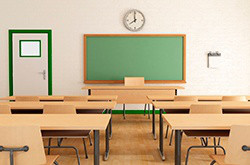 Students and teachers spend most of their school day in classrooms. And thanks to hardworking and creative teachers, these rooms are transformed into welcoming educational environments. They can bring life to an otherwise bland space with decorations and inspire students with innovative lesson plans.
Students and teachers spend most of their school day in classrooms. And thanks to hardworking and creative teachers, these rooms are transformed into welcoming educational environments. They can bring life to an otherwise bland space with decorations and inspire students with innovative lesson plans.
But with such high use and so much going on, classrooms also need to be safe environments. Places where students can learn and teachers can teach without worrying about getting hurt in an accident.
So as teachers prepare their rooms for the start of school—and maintain them throughout the year—they should be aware of dangers lurking in the classroom. And they should be equipped with simple safety precautions that can prevent injuries to themselves and their students. Consider sharing these 9 classroom safety tips with your teachers to help build a safe and secure environment:
- Keep Exits Clear. Make sure all classroom exits—both doors and windows—remain clear from obstructions and clutter.
- Safe Ladder Use. When putting up decorations or accessing materials on high shelves, always use a ladder. Do NOT stand on chairs, stools, or desks. Choose the appropriate ladder and follow ladder safety guidelines.
- Hang Decorations Properly. Avoid hanging things from light fixtures and sprinkler heads. Do not block exit signs or obstruct any exits with your decorations.
- Keep Hazardous Materials Out Of Reach. Hazardous materials, such as cleaning supplies and chemicals used for instruction, should be properly labeled and securely stored. You should also know where to find safety data sheets addressing how to properly treat exposure to hazardous materials you might have in your classroom.
- Eliminate Tripping Hazards. Do not leave unattended drawers or cabinet doors open. Make sure chairs are pushed in when students are moving around. Keep items put away when not in use to prevent tripping.
- Be Aware Of Electrical Cords. Make sure electrical cords are not running through high-traffic areas, walkways, and doorways. Do not fasten cords with staples, hang from nails, or suspend them with a wire. Don’t cover them with rugs or mats.
- Do Not Overload Electrical Circuits. Do not plug two extension cords or two surge protectors together. If your surge protector keeps resetting, you are overloading it! Be careful how many devices you are plugging into one outlet.
- Use Care When Lifting Heavy Objects. When setting up a classroom, rearranging things, or moving heavy items like textbooks, use safe lifting techniques to avoid injury.
- Post An Evacuation Plan Near The Door. Ensure all students are familiar with the exit routes in case of emergency. Post a resource for evacuations in the room, such as a map detailing the specific classroom location and highlighting the various exit routes available. After all, the closest exit may be behind you!
Classroom safety is an essential part of school risk management. It’s where students and teachers spend most of their time. So ensure your teachers are aware of classroom safety hazards and you’re equipping them with resources to create a safe learning environment for students and staff.



